Dell XPS 13 (2019) Review
Dell XPS 13 (2019) Review
The Dell XPS 13 2018 was a knockout success, earning a Trusted Reviews Recommended award and riding high in our Best Laptops round up for most of last year. It was by no means flawless, with few ports, a not-quite-best-in-class display, and an oddly-placed webcam providing a lovely view of your nostrils, among its sins. […]
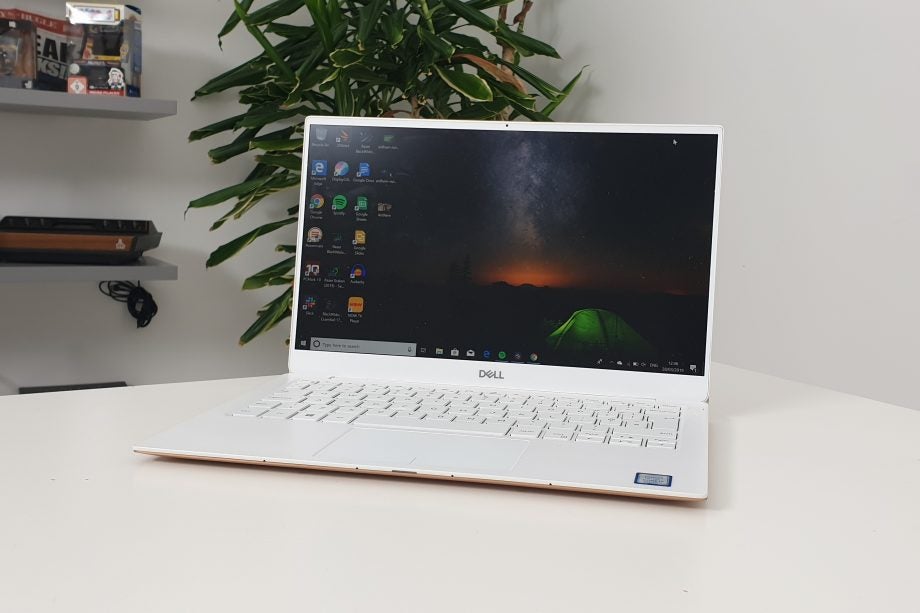
Verdict
Small but welcoming tweaks for 2019 have solidified the Dell XPS 13 as one of the very best ultrabooks you can currently buy.
Pros
- Quality design and display
- Improved performance and battery life
- Webcam moved back to top
- Huge range of configurations
Cons
- Still no full-sized SD card reader or USB port
- SSD slow at saving data
- Screen not ideal for artists
Key Specifications
- Review Price: £1399
- 13.3-inch Full HD or 4K display
- Whiskey Lake 8th-gen Intel CPUs
- Up to 16GB RAM
- Up to 1TB SSD storage
- Weight: Starting at 1.23kg
The Dell XPS 13 2018 was a knockout success, earning a Trusted Reviews Recommended award and riding high in our Best Laptops round up for most of last year. It was by no means flawless, with few ports, a not-quite-best-in-class display, and an oddly-placed webcam providing a lovely view of your nostrils, among its sins.
Come 2019, and Dell has justifiably decided not to make significant changes to the XPS 13. Instead, it’s made tiny tweaks flatten out the kinks and keep the ultrabook competitive with the likes of the LG Gram 14Z980 and Microsoft Surface Laptop 2.
So what’s new? The webcam has been shifted back to its rightful place above the screen and the processor line has been upgraded to include new Whiskey Lake CPUs. Not much else has changed, so the improvements are subtle. But, since the Dell XPS 13 was so good to begin with, those tweaks may just be enough to keep Dell the king of the ultrabooks.
Related: Best Laptops 2019
Dell XPS 13 – Design
The Dell XPS 13 is one of the sleekest laptops on the market at just 11.6mm thin. Combine that with its ultralight portability (weight starting at 1.23kg) and it’s the dream laptop for long commutes and working at the coffee shop.
That InfinityEdge display hasn’t aged a bit since the first day it was unveiled, with the super-slim and stylish 4mm bezel that’s since adopted by the majority of laptop manufacturers.
What has changed though, is the placement of the webcam – and this is most definitely for the better. Instead of your friends and family getting an upshot of your nose, they’ll now be treated to a more flattering front view of your face. Huzzah!
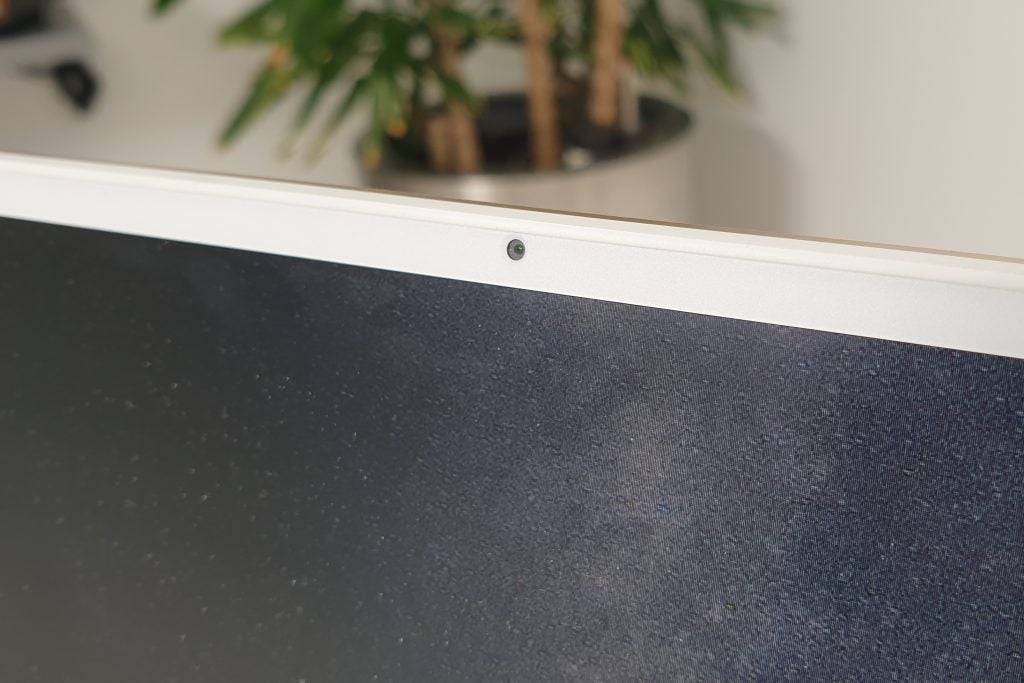
The webcam has moved to bezel above the screen, back to its traditional location
The webcam itself hasn’t been altered, offering 720p resolution. Videos still look grainy. If you’re video calling your gran, it’s perfectly adequate, but you’ll want something significantly better if you’re getting into streaming or starting up your own YouTube channel.
The arctic white interior makes a return with the glass-fibre finish, and both looks and feels as premium as ever. The review model on show here is the Rose Gold Edition, but you can now get a entirely new Dell XPS 13 colourway called Frost White which I’m personally a big fan of. The Platinum Silver Dell XPS 13 also makes a comeback.
With the design practically untouched, the Dell XPS 13 is still very robust. The interior is scratch proof, while the ultrabook has survived multiple trips in my rucksack without picking up any marks or blemishes.
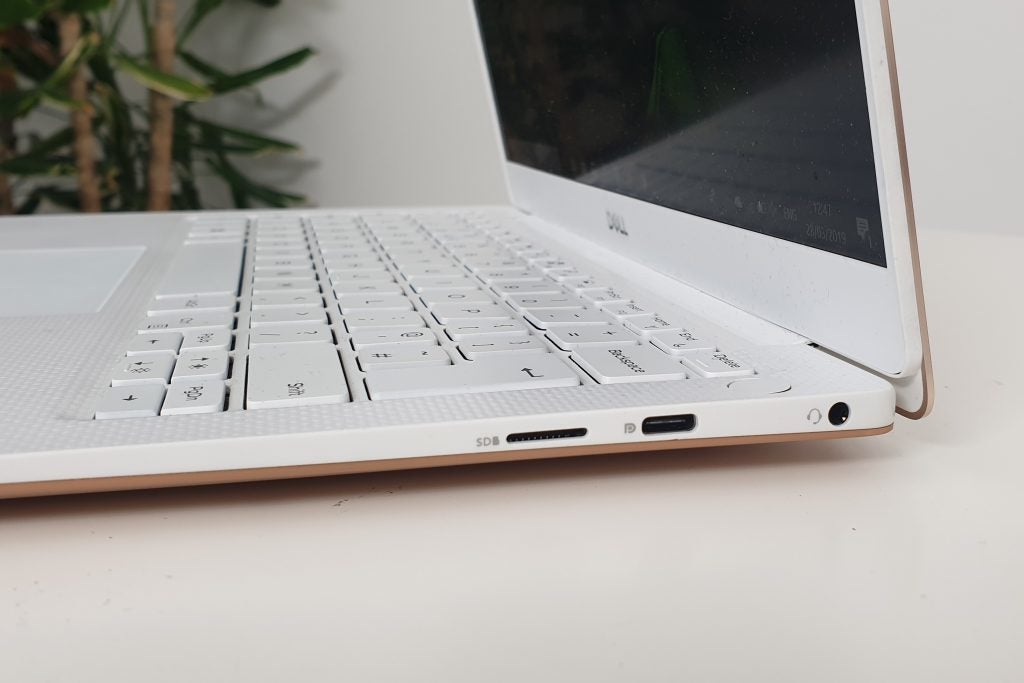
With a height of 11.6mm, this is one of the thinnest ultrabooks available
I was hoping Dell would at least add a few more ports to the XPS 13 for the 2019 refresh. One of the biggest disappointments of last year’s model was the absence of full-sized USB 3.1 ports, with Dell converting completely over to the USB-C format instead. I understand USB-C is the future, but a lot of devices – such as mice, USB sticks and external keyboards – still use USB-A. Dell does bundle a USB-C to USB-A adapter which is nice, but having to carry it everywhere is still an inconvenience.
In total, the Dell XPS has two Thunderbolt inputs, a USB-C port, a 3.5mm jack socket and a microSD card slot – the exact same offering as the previous iteration of the Dell XPS 13.
Related: Best Ultrabooks 2019
Dell XPS 13 – Keyboard and trackpad
Since there’s absolutely no changes to the keyboard and trackpad (which is broadly a good thing), I could easily get away with copy and pasting this section from the 2018 Dell XPS 13 review.
We’re big fans of the XPS 13 keyboard, with it potentially being the very best one found on a Windows laptop. The chiclet keys are nicely spaced offer good, chunky feedback for a satisfying typing experience. A lot of ultrabooks tend to squash down some of the keys, but most here are a good size so you shouldn’t be knocking out too many typos.

The Dell XPS 13 keyboard has a lovely tactile feel, with great travel and feedback
The touchpad is once again coated in glass and is as smooth as an ice rink. It’s super responsive too, as I swept through word documents and browser windows without issue. It is admittedly slightly smaller than the average laptop touchpad, but should be big enough for most users.
Related: Best Student Laptops 2019
Dell XPS 13 – Display and audio
Just as with the previous iteration, you get two 13.3-inch display options with the Dell XPS 13: a non-touch Full HD (1920×1080) screen, and a 4K (3840×2160) touchscreen – and the latter surprisingly isn’t too pricey at all. It seems Dell is using the exact same panel before, but interestingly, some of the colorimeter results differ to that found with the previous XPS 13, leading me to think Dell has done some calibrating to improve the figures.

The Dell XPS 13 pictured here has a Full HD display, but a 4K touchscreen option is also available
First off, the sRGB colour gamut seems to have increased coverage this time round from 90% to 98%. This means the new Dell XPS 13 is slightly superior for viewing digital art since it’s capable of displaying a wider range of colours.
The Adobe RGB and DCI P3 colour gamut coverages, which are both important for photography and video work, are slightly better in the Dell XPS 13 2019 too. There are only marginal improvements though, totalling up to 69% and 71% respectively. These scores are pretty good, in fact, they’re some of the best scores we’ve seen in an ultrabook and should be adequate for light photo work. Professional photographers will be wanting more though – but seeing as this laptop doesn’t have a dedicated GPU, which will help you load, edit and work on big photos more easily, this may be a moot point. Still, these scores suggest that any photos and video you view on the Dell XPS 13 will look better than they would on last year’s model.
| sRGB | Adobe RGB | DCI P3 | |
| Dell XPS 13 (2019) | 98% | 69% | 71% |
| Dell XPS 13 (2018) | 90% | 65% | 69% |
Dell’s calibration of the display has also improved the white visual colour temperature. With 6500K being the ideal target for simulating natural daylight, the Dell XPS 13 2018 had a result of 6997K which is ever so slightly cooler than the ideal display, with a slight blue tint creeping in. The Dell XPS 13 2019, on the other hand, has an almost perfect white visual colour temperature at 6558K. By just looking at the screen, you can instantly see how pure the display is here.
Otherwise, the rest of the colorimeter scores were near enough identical to what the Dell XPS 13 2018 achieved. The 0.2773 nits for black levels isn’t quite as low as you’d hope for, but thanks to a super-high white level of 408.73 nits, the contrast ends up at an impressive ratio of 1474:1.

Thanks to a great brightness and sRGB colour gamut coverage, animations like Rick and Morty look ace on the XPS 13
The speakers here are identical to the ones found in the XPS 13 2018 – you may have started to notice a pattern in my review.
Volume can hit a decent decibel and audio quality is pretty solid for a gaming laptop. But as ever, the laptop’s speaker is no alternative for a certified sound system.
Dell XPS 13 – Performance
Forget the webcam, the jump to a Whiskey Lake processor is arguably the best upgrade for the new Dell XPS 13. That said, even this isn’t a game-changing boost, since the previous iteration already had an 8th Generation Intel CPU in the forms of the i7-8250U and i7-8550U.
With the new Dell XPS 13, you get the choice of an Intel Core i3-, i5- or i7 Whiskey Lake processor. These should offer a slight bump in performance power compared to the previous Dell XPS 13. The upgrade will also likely see more efficient power management, resulting in a better battery life.
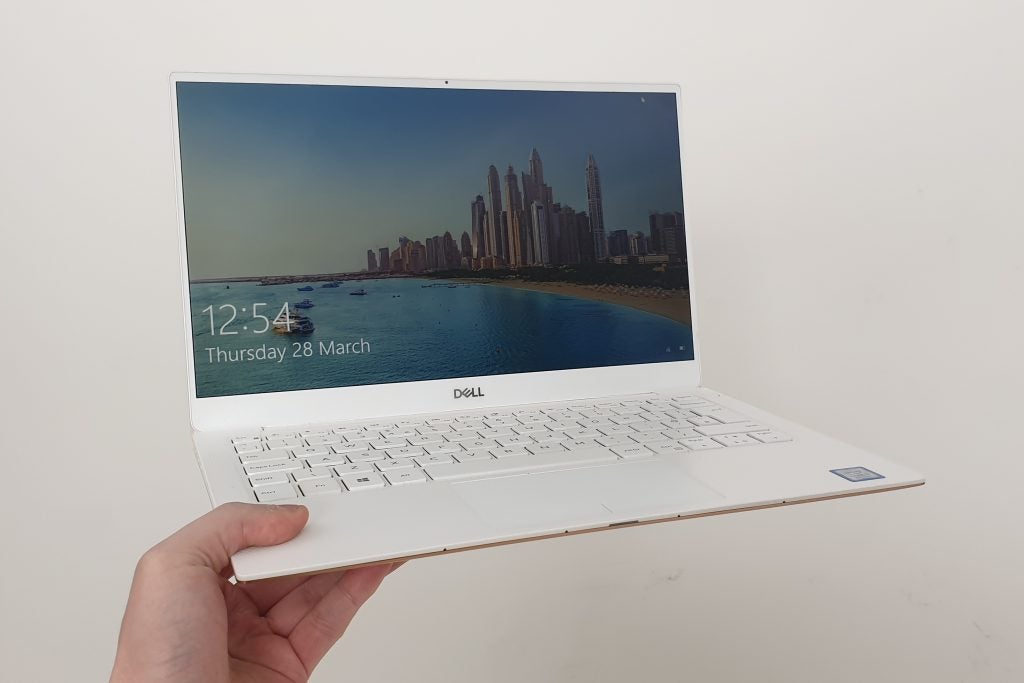
Despite packing serious power, the Dell XPS only weighs 1.23kg
Other configuration options include memory, with 4GB, 8GB and 16GB LPDDR3 RAM configurations available. And let’s not forget storage, which ranges from a 128GB PCle NVMe SSD to a whopping 1TB PCle SSD.
| Option 1 | Option 2 | Option 3 | |
| Price | From £999 | From £1249 | From £1399 |
| CPU | i3-8145U | i5-8265U | i7-8565U |
| RAM | 4GB | 8GB | 8GB
16GB |
| GPU | Intel UHD Graphics 620 | Intel UHD Graphics 620 | Intel UHD Graphics 620 |
| Storage | 128GB SSD | 256GB SSD | 256GB SSD
512GB SSD 1TB SSD |
| Display | 13.3-inch Full HD non-touch | 13.3-inch Full HD non-touch
13.3-inch 4K touchscreen |
13.3-inch Full HD non-touch
13.3-inch 4K touchscreen |
| Colours | Platinum Silver |
Platinum Silver Rose Gold |
Platinum SilverRose Gold |
The model I have on review here has an Intel Core i7-8565U processor, 8GB RAM, 256GB SSD and a 13.3-inch Full HD display – and all of this is packed in a Rose Gold shell. This specific model is priced at £1479, but prices drop to £999 for the cheapest model, and spiral up as high as £1929 for the most expensive.
I’m impressed with how many different configurations Dell has on offer here. The only other configuration I’d like to see is a Dell XPS 13 with a dedicated GPU, as only integrated Intel UHD Graphics 620 are on offer here. But dGPUs can take up space, so this could potentially compromise the compact size.
That said, the lack of a dedicated GPU means the Dell XPS 13 struggles with savvy media tasks such as 3D modelling, 4K video editing as well as playing AAA video games. The results for 3DMark Ice Storm – a benchmark test that analyses the GPU performance of a device – also shows the XPS 13 lags behind competing ultrabooks that also have integrated graphics cards. If you’re intending on doing any sort of high-demanding media work, then the Dell XPS 13 is really not for you.
| XPS 13 2019 (i7-8565U + 8GB RAM) |
XPS 13 2018 (i7-8550U + 16GB RAM) |
LG Gram 14 (i5-8250U + 8GB RAM) | Surface Laptop 2 (i5-8250U + 8GB RAM) | |
| Geekbench single-core |
4877 | 4676 | 4085 | 3050 |
| Geekbench multi-core | 14509 | 15262 | 11888 | 10873 |
| PCMark 10 | 3847 | – | 3170 | 2216 |
| 3DMark Ice Storm |
47,144 | – | 67,216 | 50,847 |
| CrystalDiskMark read | 2221.4 MB/s | 3039.6 MB/s | 550.6 MB/s | 1637.5 MB/s |
| CrystalDiskMark write | 326.5 MB/s | 483.2 MB/s | 504.9 MB/s | 776 MB/s |
The CPU performance is a different story though. The Dell XPS 13 is lightning quick when browsing the web and ploughing through word documents and the like. Our benchmark results backed up these speeds, with the PCMark 10 and Geekbench multi-core scores trouncing the figures produced by the LG Gram 14 and Surface Laptop 2.
That said, the table above isn’t really a fair contest, with XPS 13 configuration used here boasting an i7 CPU, while the Gram and Surface only have an i5. Unfortunately, these are the only benchmark results I have at hand for these devices, but I will update the table once we’ve tested more comparable configurations.
The Dell XPS 2018 results have also been skewed here thanks to the device’s stonking 16GB RAM. The configuration of the Dell XPS 2019 I have on test only has 8GB RAM, so it’s difficult to see how significantly the Whiskey Lake processor has improved the performance. We do at least know the new XPS 13 is blitzing fast. Despite how powerful this laptop is though, it never seemed to get warm and the fans never became noticeably loud.
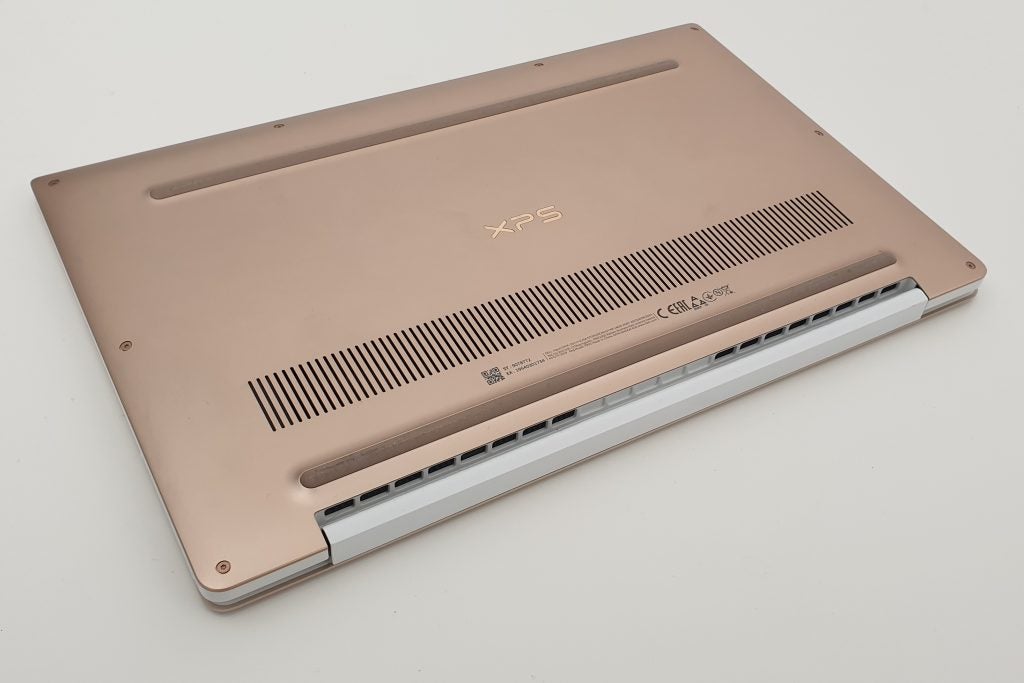
The cooling system does a great job of preventing the Dell XPS 13 from overheating or making noise
Meanwhile, the read and write speeds of the SSD are a mixed bag and surprisingly inconsistent with the previous XPS 13. The CrystalDiskMark read score of 2221.4 MB/s is a significant drop from the 3039.6 MB/s reading found with the 2018 model. Compared to competitors though, the new Dell XPS 13’s read scored still holds up well, beating both the LG Gram and Surface Laptop 2 comfortably, so Dell should still be able to read data from the drive as a satisfying speed.
It’s not such a pretty picture for the CrystalDiskMark write score though with a subpar reading of 326.5 MB/s. This is lower than both the LG Gram and Surface Laptop, so the new Dell XPS 13 looks to be one of the slowest premium ultrabooks when saving and storing date on the drive.
Dell XPS 13 – Battery
The upgrade to a Whiskey Lake not only means the new Dell XPS 13 should get a performance boost, but also an extended battery life thanks to more efficient power management. Our battery benchmark test backed up this theory.
The new Dell XPS 13 lasted 13 hours and 30 minutes on our standard battery test. This consists of setting the brightness to 150 nits and using Powermark to loop 10 minutes of web browsing and five minutes of video playback until the laptop runs out of juice.
The previous Dell XPS 13 managed to last between 12 and 13 hours throughout various battery tests. That means there hasn’t been a substantial improvement since the latest model, but I still welcome any battery life increase, regardless how minor.
Why buy the Dell XPS 13?
The Dell XPS 13 was already one of the best ultrabooks you can buy, and with slight tweaks it’s only got better in 2019. The webcam has been shifted to its traditional place, the upgrade to a Whiskey Lake processor has improved performance and battery life and apparent calibrations to the display has widened its sRGB colour gamut coverage.
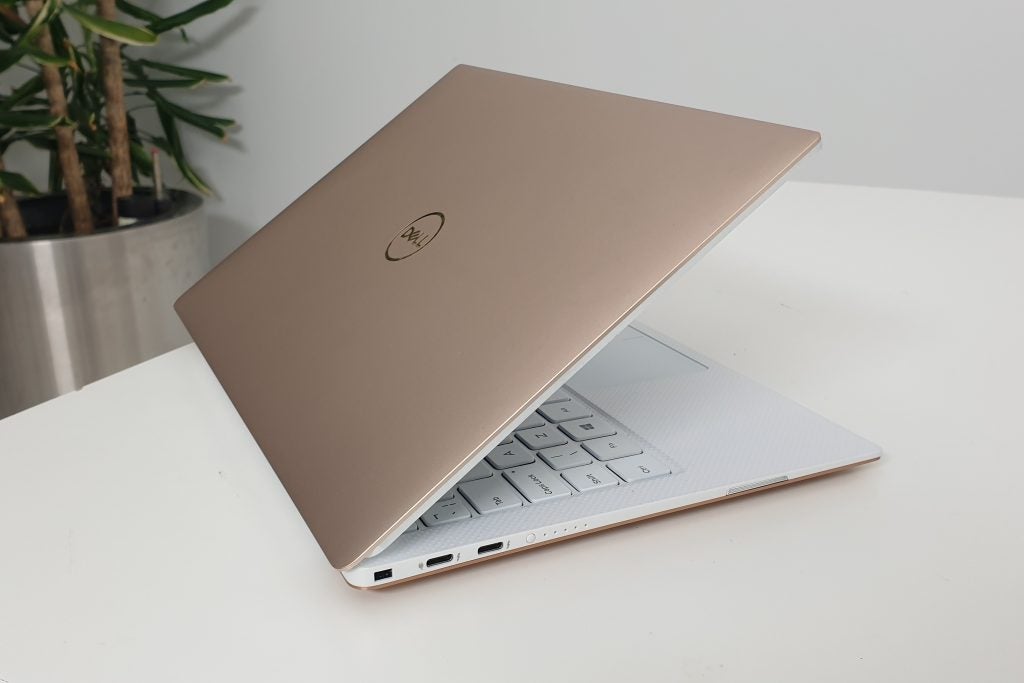
The Dell XPS joins the LG Gram as one of the best ultrabooks on the market
The new Dell XPS 13’s massive range of configurations means you’ve got a lot of flexibility here too. There’s options for a 1TB hard drive, Intel Core i7-8565U processor, 16GB RAM and a 4K touchscreen, so you’ve able to plump for a really pimped out machine. I just wish there was also the option of a dedicated graphics card, and with competing ultrabooks like the Asus ZenBook Pro 14, Huawei MateBook X Pro and Razer Blade Stealth 13 currently rocking GPUs, Dell can’t use the XPS 13’s small form factor as an excuse.
The Dell XPS 13 still isn’t perfect with a stingy offering of ports and surprisingly slow write speeds – but both of these are very minor flaws that are easy to overlook. All in all, this is one of the very best ultrabooks available. If you’re looking for a powerhouse ultra-portable, the Dell XPS 13 should be at the front of your shortlist.
Verdict
Small but welcoming tweaks for 2019 have solidified the Dell XPS 13 as one of the very best ultrabooks you can buy.
How we test laptops
Unlike other sites, we test every laptop we review thoroughly over an extended period of time. We use industry standard tests to compare features properly. We’ll always tell you what we find. We never, ever, accept money to review a product.


